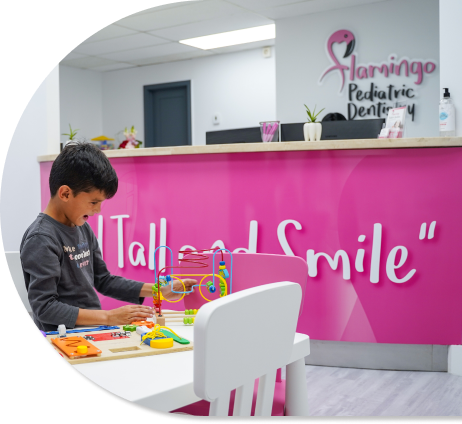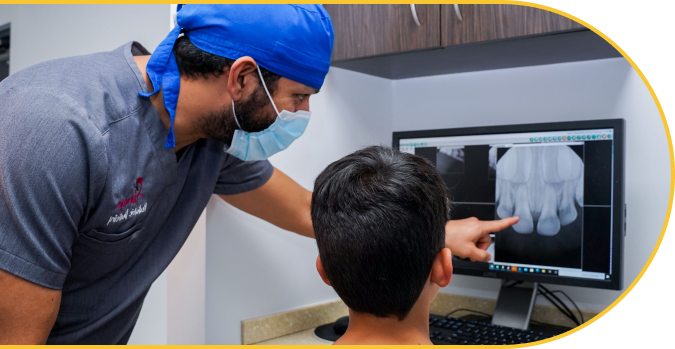 Composite (White) Fillings
Composite (White) Fillings
Tooth-colored fillings are the most lifelike material used to fill cavities. Composite fillings can be done in one visit. Once the decay is removed, the tooth is filled with this composite material that hardens immediately after placement.

 Pulp Treatment (Pulpotomy/Pulpectomy/Baby Root Canal)
Pulp Treatment (Pulpotomy/Pulpectomy/Baby Root Canal)
Root canals involve treating decay that has reached the nerve. If the inside of the tooth, known as the dental pulp, is infected a “baby root canal” is recommended. The pulpotomy involves cleaning the nerve and restoring the tooth until it is time for it to exfoliate (or fall out on its own naturally).
 Crowns
Crowns
Crowns are used to restore damaged or decayed teeth in children. Crowns completely cover the remaining tooth structure after it has been treated. They can be made with many different materials, including stainless steel, polycarbonate, porcelain, and zirconia.
 Extractions
Extractions
We like to call this “The Wiggle” which often happens when a tooth can not be saved with restorative materials and may need to be removed.
Reasons for Tooth Extractions in Kids
Most commonly, pediatric dentists will recommend extraction if:
- There’s an infection under the tooth (Abscess).
- Cavity too large to be fixed with a filling or crown.
- Dental trauma has occurred.
- Periodontal disease.
- Orthodontic needs – baby tooth preventing adult tooth from development.

 Nitrous Oxide
Nitrous Oxide
Nitrous oxide, or laughing gas, is the most frequently used method for easing mild to moderate anxiety in children. This helps facilitate dental treatment needs and ease pain, anxiety or hyperactive gag reflex that may accompany the procedure. Your child will inhale nitrous oxide through a tiny mask placed over the nose. He or she should not experience any adverse effects. According to the American Academy of Pediatric Dentistry, less than 0.5% of young patients have nausea or vomiting. We advise parents to keep their children from eating for 2 hours prior to the procedure so they don’t get sick while drowsy.
At the end of your child’s appointment, he or she will resume breathing regular oxygen, and all the effects of nitrous oxide will disappear. As your child gets older and becomes more comfortable during dental visits, nitrous oxide may not be necessary.


Restorative Services
 Composite (White) Fillings
Composite (White) Fillings
Tooth-colored fillings are the most lifelike material used to fill cavities. Composite fillings can be done in one visit. Once the decay is removed, the tooth is filled with this composite material that hardens immediately after placement.
 Pulp Treatment (Pulpotomy/Pulpectomy/Baby Root Canal)
Pulp Treatment (Pulpotomy/Pulpectomy/Baby Root Canal)
Tooth-colored fillings are the most lifelike material used to fill cavities. Composite fillings can be done in one visit. Once the decay is removed, the tooth is filled with this composite material that hardens immediately after placement.
 Crowns
Crowns
Crowns are used to restore damaged or decayed teeth in children. Crowns completely cover the remaining tooth structure after it has been treated. They can be made with many different materials, including stainless steel, polycarbonate, porcelain, and zirconia.
 Extractions
Extractions
We like to call this “The Wiggle” which often happens when a tooth can not be saved with restorative materials and may need to be removed.
Reasons for Tooth Extractions in Kids
Most commonly, pediatric dentists will recommend extraction if:
- There’s an infection under the tooth (Abscess).
- Cavity too large to be fixed with a filling or crown.
- Dental trauma has occurred.
- Periodontal disease.
- Orthodontic needs – baby tooth preventing adult tooth from development.

We know hearing your child needs a tooth extracted can be stressful, but we are here to ease the anxiety involved with the procedure. Before removing the tooth, the area will be numbed with local anesthesia. The tooth is then loosened using a special dental instrument known as an elevator. After the tooth is loosened from the socket, it is removed.
 Nitrous Oxide
Nitrous Oxide
Nitrous oxide, or laughing gas, is the most frequently used method for easing mild to moderate anxiety in children. This helps facilitate dental treatment needs and ease pain, anxiety or hyperactive gag reflex that may accompany the procedure. Your child will inhale nitrous oxide through a tiny mask placed over the nose. He or she should not experience any adverse effects. According to the American Academy of Pediatric Dentistry, less than 0.5% of young patients have nausea or vomiting. We advise parents to keep their children from eating for 2 hours prior to the procedure so they don’t get sick while drowsy.
At the end of your child’s appointment, he or she will resume breathing regular oxygen, and all the effects of nitrous oxide will disappear. As your child gets older and becomes more comfortable during dental visits, nitrous oxide may not be necessary.

